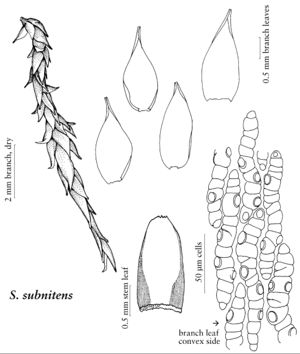Difference between revisions of "Sphagnum subnitens"
Verh. Bot. Vereins Prov. Brandenburg 30: 115, plate 3, fig. 9, plate 4, figs. 22, 23. 1888,.
FNA>Volume Importer |
imported>Volume Importer |
||
| (2 intermediate revisions by 2 users not shown) | |||
| Line 45: | Line 45: | ||
|publication year= | |publication year= | ||
|special status= | |special status= | ||
| − | |source xml=https:// | + | |source xml=https://bitbucket.org/aafc-mbb/fna-data-curation/src/2e0870ddd59836b60bcf96646a41e87ea5a5943a/coarse_grained_fna_xml/V27/V27_103.xml |
|genus=Sphagnum | |genus=Sphagnum | ||
|section=Sphagnum sect. Acutifolia | |section=Sphagnum sect. Acutifolia | ||
Latest revision as of 21:24, 5 November 2020
Plants moderate-sized, relatively robust, smaller in exposed sites, elongated in shaded sites, soft, capitulum ± large; pale green, green, yellowish, yellow-brown, brown, pinkish, purplish; with strong metallic sheen when dry. Stems brown or purplish; superficial cortical cells aporose. Stem leaves triangular to triangular-lingulate, 1.2–1.7 mm, apex acute to sometimes shortly cuspidate due to involute margins near apex, border narrow at base (less than 0.25 width); hyaline cells mostly efibrillose and aporose, 0–1(–2)-septate. Branches long and tapering, unranked. Branch fascicles with 2 spreading and 1–2 pendent branches. Branch leaves 1.3–2.7 mm, ovate to ovate-lanceolate, 1.3–2.7 mm, concave, straight, apex involute; hyaline cells on convex surface with 2–6 large, narrowly elliptic ringed pores along the commissures, but usually absent from marginal regions of leaf, concave surface aporose or with 1–4 large round pores per cell especially near base. Sexual condition monoicous. Spores 22–32 µm, finely to irregularly coarsely-papillose on proximal surface, irregularly coarsely papillose on distal surface; proximal laesura less than 0.5 spore radius.
Phenology: Capsules mature early summer.
Habitat: Coastal oceanic mires that range from weakly to moderately minerotrophic
Elevation: low to moderate elevations
Distribution
B.C., Alaska, Calif., Oreg., Wash., Eurasia, Pacific Islands (New Zealand).
Discussion
Sporophytes are common in Sphagnum subnitens. The ecology of this species is unclear because of past taxonomic confusion with S. subfulvum. However, the two clearly differ in gametophyte and spore morphology (K. I. Flatberg 1985; Cao T. and D. H. Vitt 1986). The metallic sheen and strongly pointed stem leaves will distinguish this species from the somewhat similar S. capillifolium. See also discussion under 83. S. subfulvum.
Selected References
None.
